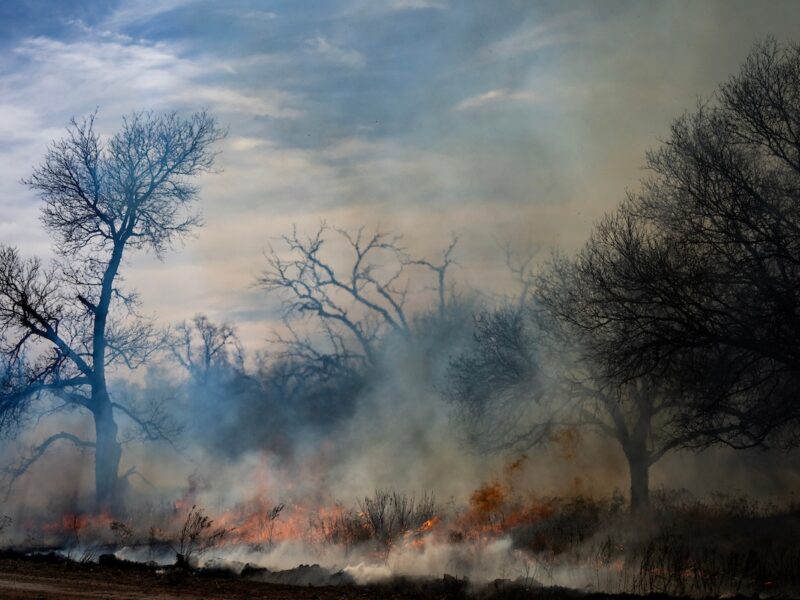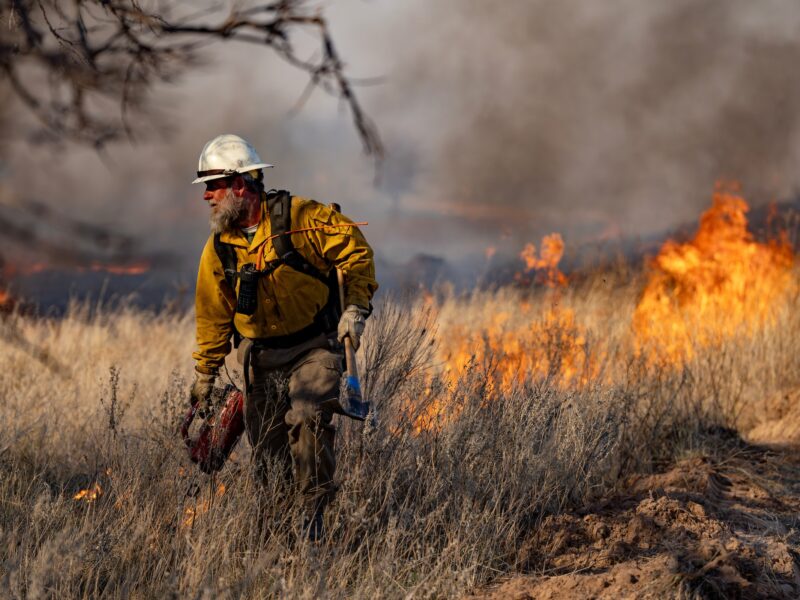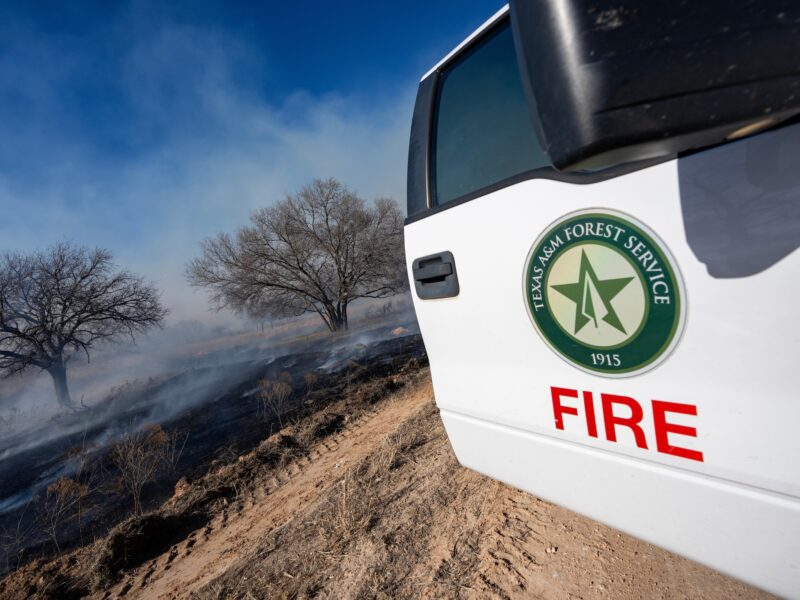Tree Care After Winter Storm Uri
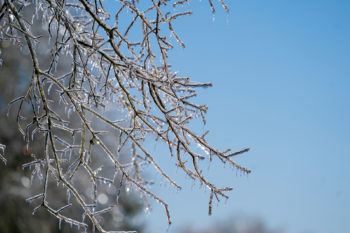
It has been almost six months since Winter Storm Uri blanketed Texas in a week-long freeze, and despite ample rain, many Texas trees are still showing signs of stress. Tufts of leaves give some a patchy, inverted look, while others are losing vast amounts of bark or seemingly dying overnight, leaving many Texas home and landowners wondering what they should do.
The Texas A&M Forest Service and Neil Sperry, the Texas gardening and horticulture expert, joined forces this spring to send a unified message across the state: wait. More specifically, Gretchen Riley, the Urban and Community Forestry program leader at Texas A&M Forest Service, asked Texans to wait until mid-July before cutting down leafless trees.
The good news is that the vast majority of trees that were late to leaf out have mostly, if not fully, recovered. Sickly or struggling trees are harder to come by, and time has lent a level of clarity as to the state and likelihood of survival for most struggling trees.
“The waiting was important, because we’re just now beginning to differentiate between those trees that are obviously not going to survive, those that are wounded and we hope will survive, and those that are definitely going to survive but are going to take a little while to come back,” said Sperry, who has been studying the recovery of Texas trees for the past several months.
Now the time has come for Texans to make a decision: to remove their trees or not.
The Short Answer
According to Riley, if your tree is bare and hasn’t put out a single leaf by now, it is almost certainly dead. Waiting a few more weeks, or even months, won’t change that. And unfortunately, this applies across the board, even to palm trees.
“Anything green means that the tree has a chance for recovery,” Riley said. “But a single small frond should have grown and opened on palm trees by now. No green means it is dead and has already started rotting internally.”
If this is the case for any of your trees, it is probably time to consider how and when to remove your tree. The short answer: remove when convenient and with the help of a professional or certified arborist.
The Long Answer
By this point, few trees are still completely bare. The more common scenario that arborists and foresters are seeing across the state is trees with poor or patchy canopies. By this point in the summer, and with all the rain we’ve been receiving, healthy trees should already have a full canopy of leaves. The ones that don’t were clearly affected by the freeze.
This isn’t to say they won’t be healthy and happy come next spring. And there are a few ways to determine if your tree is in good shape, or if it could use a helping hand.
“Trees that have 50% or more of their normal canopy are likely to survive,” said Sperry, referring to hardwoods and established trees. “But if it’s a 20% or 30% canopy over the whole tree, then that tree has suffered a bad hit, and it may not have enough to come back.”
It can be hard to remember what a full canopy looked like for a previously healthy tree, so Riley has come up with another method for determining a tree’s state.
“Imagine a circle around all of your tree’s branches,” Riley said. “Twenty-five percent or more of that circle should be filled in with leaves. If not, that tree is most likely going to die, and it is worth planning to remove it. If more than 25% of that circle is filled with leaves, there is still a chance for full recovery.”
One way you can monitor your tree’s progress is by taking a photo of your tree’s canopy as soon as possible. Keep that photo — remembering the angle you took it from — and then wait for next spring. Once the tree has fully leafed out, take another photo from that same spot, and compare the pictures for improvements. If there is more foliage next spring, that means the tree is in recovery.
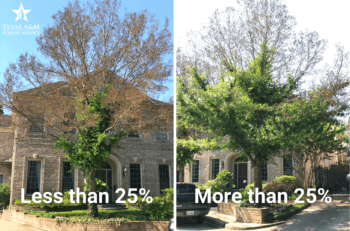
Other Complications
Patchy foliage isn’t the only mark of a stressed or struggling tree. Many Texas landowners are finding deep, wide cracks in the trunks of their oak trees. According to Riley, these are an exaggerated manifestation of the more typical frost cracks or “radial shakes.”
“Frost cracks are caused by a tree’s inability to endure expansion and contraction of the bark and wood that results from the freezing of water inside of the tree,” Riley said.
Many of these cracks were only partially visible, if not invisible, following the winter storm. The recent surge of summer heat, however, has exacerbated those cracks, making them more visible in some trees.
“The good news is that trees have amazing, built-in mechanisms for recovering from trunk damage and frost cracks,” Riley said. “So, trees with one or two cracks should be able to seal themselves with relative ease.”
On the flip side, bark is still essential for protection against pests and diseases. Trees with multiple cracks or lots of exposed wood are unlikely to recover, and trees with few but deep cracks should be monitored closely. The few exceptions are lacebark elms, sycamores and crepe myrtles. These are more likely to survive since, in most cases, the damage appears to be a shredding of the outermost layer of bark, sparing the wood itself. However, you should still watch closely for oozing discharge and other signs of stress, such as browning foliage or expanding cracks, leading up to next spring.
Tree Pruning And Removal
There are few decisions more difficult than when or how to remove a tree from your property. Trees have immense sentimental and monetary value. But their worth is rarely more than your roof, your house or your life.
You can start by removing dead branches or by pruning back the dead ends of branches on trees that experienced significant dieback. These branches are more likely to break off and injure property or people than the main body of the tree. It is still a dangerous and difficult task though, and the Texas A&M Forest Service — along with Sperry and countless other industry experts — highly recommends enlisting the services of an I.S.A. certified arborist.
This article by Stephen O’Shea originally appeared on AgriLife Today.
